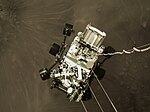TOI-4138 b is a transiting exoplanet orbiting the G-type subgiant TOI-4138 1,674 light years away in the northern circumpolar constellation Ursa Minor.
Discovery
The planet was discovered by TESS using the transit method, which involves measuring light curves during a planet’s eclipse. The paper states that it’s inflated due to heating from its host star, which has a high luminosity.[2] Its discovery was announced in October 2021.
Properties
Orbit and mass
TOI-4138 b has an orbital period of 3.6 days, typical for a hot Jupiter. This corresponds to a separation from its host close to one eighth of the distance of Mercury from the Sun. Since the inclination is known, doppler spectroscopy measurements give the planet a mass only 67% that of Jupiter.[1] Its separation is comparable with HD 209458 b, but is much larger due to the evolved state of the host star.[1]
Radius and density
TOI-4138 b’s transit gives it a radius 1.49 times that of Jupiter; this combined with its low mass of 0.67 MJ gives it a density only 25% that of water.[1]
Host star
TOI-4138 b orbits TOI-4138, a subgiant star[1] located in the constellation Ursa Minor. The star has an enlarged radius of 1.82 R☉, a luminosity of 4.37 L☉ and an effective temperature of 6,128 K (5,855 °C).[1] It has 1.32 times the Sun's mass, and it has an intermediate age of around 3.5 billion years.[1] The apparent magnitude of the star is 11.8, making it not visible to the naked eye.[3]
References
- ^ a b c d e f g h i Montalto, M.; Malavolta, L.; Gregorio, J.; Mantovan, G.; Desidera, S.; Piotto, G.; Nascimbeni, V.; Granata, V.; Manthopoulou, E. E.; Claudi, R. (January 2022). "TIC 257060897b: An inflated, low-density, hot-Jupiter transiting a rapidly evolving subgiant star". Monthly Notices of the Royal Astronomical Society. 509 (2): 2908–2919. arXiv:2110.00489. Bibcode:2022MNRAS.509.2908M. doi:10.1093/mnras/stab2923. ISSN 0035-8711.
- ^ Davis, Margaret (12 October 2021). "NASA Discovered "Hot Jupiter" Exoplanet, Bigger But Less Massive Than Solar System's Largest Planet". Science Times. Retrieved 23 December 2021.
- ^ "★ TIC 257060897". Stellar Catalog. Retrieved 2024-04-09.











